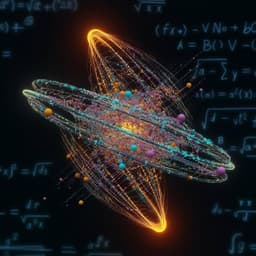
Engineering and Technology
SRS-Net: a universal framework for solving stimulated Raman scattering in nonlinear fiber-optic systems by physics-informed deep learning
Y. Song, M. Zhang, et al.
Discover how SRS-Net, a groundbreaking physics-informed neural network framework, revolutionizes stimulated Raman scattering (SRS) in fiber-optic systems. Developed by Yuchen Song, Min Zhang, Xiaotian Jiang, Fan Zhang, Cheng Ju, Shanguo Huang, Alan Pak Tao Lau, and Danshi Wang, this innovation promises two orders of magnitude faster solutions, enhancing the accuracy and versatility of SRS problem-solving. Join us in exploring this exciting leap in optical technology!
~3 min • Beginner • English
Introduction
Stimulated Raman scattering (SRS) in optical fibers mediates power transfer from higher to lower frequencies and impacts both system impairments and device operation (e.g., Raman amplifiers). Forward SRS problems predict power evolution given inputs and known fiber parameters, while inverse problems infer unknown parameters or optimize pump powers from measured input–output profiles. Classical numerical solvers (split-step methods, shooting algorithms) are scenario-specific, struggle with bidirectional propagation, and are inefficient or unstable for combined forward–inverse workflows. Data-driven neural networks can approximate forward maps and enable inverse optimization but require large labeled datasets, suffer from generalization issues, and lack physical interpretability. Physics-informed neural networks (PINNs) embed PDE constraints in training, offering accurate, interpretable solutions for nonlinear PDEs. This work proposes SRS-Net, a PINN tailored to the SRS governing equations, to provide a universal, efficient framework that simultaneously addresses forward prediction, parameter identification, and pump optimization, including combined scenarios and bidirectional propagation.
Literature Review
The paper reviews: (1) Classical numerical methods for SRS: split-step methods for unidirectional propagation; shooting algorithms for bidirectional cases with potential instability and time cost; iterative search for inverse problems due to lack of differentiability. (2) Data-driven neural networks for SRS: prediction of gain/ASE under partial loading; embedding fiber characteristics to improve generalization; paired forward/backward NNs for pump optimization; experimental demonstrations for span loss prediction and pump optimization; multiple NN models for Raman amplified links including closed-form parameter prediction. These methods are limited by costly dataset collection, coverage/generalization issues, and non-unique mappings hindering parameter identification. (3) Physics-informed approaches: PINNs have solved PDEs in fluid dynamics, reaction-diffusion, Burgers’ equation, and the NLSE in nonlinear optics. Prior differentiable SRS models exist but are limited (e.g., forward pumping only). The review identifies the need for a universal, interpretable, differentiable framework that handles forward, inverse, and combined SRS problems across practical scenarios.
Methodology
SRS-Net is a physics-informed neural network specialized for SRS-governed dynamics in fiber optics. Governing equations: a coupled SRS PDE for complex field envelopes A_k(z,t) across M WDM channels incorporates attenuation α_k, group velocity dispersion β_2k, Kerr nonlinearity γ_k, and inter-channel Raman coupling via g_kj(Δf). For continuous-wave (CW) scenarios, the PDE reduces to coupled SRS ODEs by neglecting dispersion and Kerr terms. Raman coupling coefficients are frequency dependent through the Raman gain spectrum g_R(Δf) and effective area A_eff. Neural formulation: The NN inputs are independent variables (e.g., z, t; in frequency-domain cases, spatial-frequency coordinates), and outputs are the complex field per channel represented by real and imaginary parts (u_k, v_k), totaling 2M outputs. Some physical coefficients (e.g., α_k, γ_k, g_R profile) can be treated as optimizable variables. Loss: L = L_e + L_r, where L_e is a data term enforcing known/measured boundary/initial/final conditions (e.g., input/output spectra), and L_r enforces PDE residuals f(z,t,θ,A)=0 at collocation points over the full solution domain. Automatic differentiation computes necessary spatial/temporal derivatives of NN outputs to build the residual. For forward problems, L_e encodes initial conditions (at z=0 or z=z_max depending on direction), enabling simultaneous solution across the full domain, including bidirectional cases. For inverse problems, L_e encodes measured input/output data while unknown physical parameters and/or pump powers are optimized jointly with NN weights under PDE constraints. Pump optimization extends the NN inputs to include pump powers and augments the loss with regularization (e.g., total pump power). Training strategies: adaptive weighting of loss terms stabilizes training for difficult bidirectional cases (e.g., stage-wise emphasis on signal boundary first, then pumps). Implementation uses AD (e.g., JAX) for residual derivatives and Adam optimization with tanh activations. Hyperparameters vary by task (e.g., trunk/branch widths 50–200, depths 4–6; iterations 8e2–2e4). Experimental methodology: an 8-span C+L-band WDM setup (96 channels over ~10 THz) with measured EDFA gains and connector losses is used. Few measured input–output spectra per span enable simultaneous identification of frequency-dependent attenuation α_f(f) and Raman gain g_R(f) via SRS-Net; then forward power evolution and QoT (GSNR via GN model) are predicted and validated against OCM measurements. Performance baselines include split-step Fourier method (SSFM), shooting methods for bidirectional problems, genetic algorithm (GA) and differential evolution (DE) for inverse tasks.
Key Findings
- Continuous-wave two-wave co-propagation: SRS-Net matches SSFM (100 m step) with maximum power error < 0.1 dB; RMSE between complex fields typically < 3×10^−3, with slightly higher errors at the start due to stronger SRS. - Time-domain pulse propagation (50 ps pulses): Accurate capture of SRS build-up, walk-off, pump narrowing and asymmetry; overall RMSE < 6×10^−4, peaking around 1.5 walk-off lengths where SRS is strongest. - 16-symbol 20-GBaud 16-QAM sequences over 80 km: Maximum RMSE < 0.06 versus SSFM; clear pump-to-signal energy transfer observed. - Multi-channel C+L-band (96 channels, 100 GHz spacing): Accurate partial/full loading evolution with low RMSE distributions across 20–120 km; initial conditions learned from input spectra only; slight RMSE increase with distance yet remaining low. - Forward bidirectional Raman amplification (CO/CT/BI): With adaptive loss weighting, SRS-Net stably predicts longitudinal power profiles across all three pump configurations; maximum error < 0.3 dB relative to ground truth, avoiding instability issues typical of shooting methods. - Inverse parameter identification: Raman gain spectrum identification across three fiber types (SMF, DCF, PSCF) achieved with RMSE < 0.2. In experimental span #7, SRS-Net accurately identifies frequency-dependent attenuation α_f(f) and Raman gain g_R(f) from only six input–output spectrum pairs, converging from simple initial guesses to measured profiles. - Pump power optimization (CT, four pumps, 96-channel C+L over 80 km): Starting from non-optimized pumps, SRS-Net reduces output ripple from 6.5 dB to 2.2 dB (C-band) and from 2.5 dB to 0.8 dB (L-band). With improved pump frequencies (200/205/207.5/209 THz), maximum deviation to target spectrum drops from 5.4 dB to 0.86 dB (GA: 1.3 dB). Average deviation to target: 0.8 dB (SRS-Net) vs 1.7 dB (GA). - Experimental C+L-band multi-span transmission: Using identified α_f(f) and g_R(f), SRS-Net predicts power spectra under full and partial loading with maximum deviation < 0.3 dB, matching OCM measurements closely. QoT estimation via GN model yields GSNR prediction errors reduced from >3 dB (without accurate parameters) to <0.8 dB. - Physics consistency and generalization: SRS-Net’s PDE residual converges to ~1×10^−8 without labeled training data; data-driven NN achieves low data loss (~1×10^−6) but shows high/unstable physics residuals, underscoring SRS-Net’s physical fidelity and generalization under constraints. - Speed and efficiency: Inference time for SRS-Net is nearly independent of distance and scales weakly with channel count; achieves ~100× speedup over SSFM for 120 channels over 120 km. For inverse tasks, SRS-Net converges ~2.5× faster than DE for Raman gain identification (≈16 min vs ≈40 min) and ~3× faster than GA for pump optimization (~15 min vs ~45 min) with comparable or better accuracy and improved stability.
Discussion
By embedding the SRS PDE into a neural solver, SRS-Net addresses the central challenge of simultaneously handling forward, inverse, and combined SRS problems with a single, interpretable framework. It eliminates dependence on direction-specific numerical schemes by solving across the entire domain, naturally accommodating bidirectional propagation. The use of automatic differentiation enables direct optimization of physical parameters and pump powers, converting ill-posed inverse tasks into well-regularized problems constrained by physics. Experiments confirm that accurate identification of both attenuation and Raman gain spectra is essential for high-fidelity power evolution, which in turn improves QoT estimation accuracy (GSNR). Compared with data-driven NNs, SRS-Net’s physics regularization ensures consistency with governing laws, improving extrapolation robustness. Compared with classical solvers and heuristic optimizers, it provides large speedups at inference and faster convergence in optimization, reducing expert-tuned algorithmic complexity while maintaining high accuracy.
Conclusion
The paper introduces SRS-Net, a physics-informed deep learning framework that unifies forward power evolution prediction, inverse parameter identification, and pump power optimization for SRS in fiber-optic systems. Through simulations and a wideband C+L-band experiment, SRS-Net demonstrates high accuracy (sub-dB errors in power, sub-dB GSNR errors), robustness for bidirectional propagation, significant inference speedups over SSFM (~two orders of magnitude), and faster convergence than DE/GA in inverse tasks. The approach requires only boundary (input/output) data for identification, is interpretable via explicit PDE residual minimization, and generalizes across loading conditions. Future directions include incorporating SRS-related noise and other stochastic effects, extending to broader classes of nonlinear PDE-governed photonic systems, exploring improved training curricula/initialization for challenging bidirectional cases, and integrating with network control/digital twin frameworks for real-time operation.
Limitations
- Convergence is not mathematically guaranteed; training may require careful initialization and adaptive loss weighting, especially for strong bidirectional pumping. - A training phase is needed before fast inference; benefits are largest when many forward predictions are required. - Accuracy depends on correct modeling of physical effects; unmodeled phenomena (e.g., noise sources, load-dependent EDFA behavior) can limit fidelity unless explicitly integrated. - Parameter identification quality relies on representative boundary measurements; insufficient or biased input–output data can degrade results. - Certain configurations (e.g., pump frequency selections) can inherently limit attainable flatness, requiring reconfiguration beyond mere power optimization.
Related Publications
Explore these studies to deepen your understanding of the subject.







